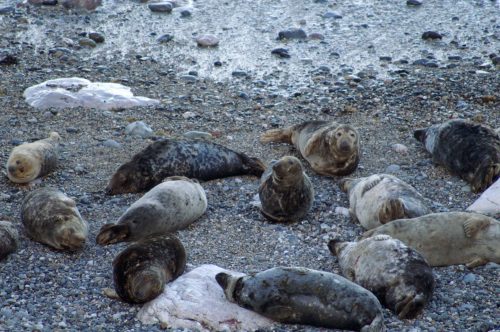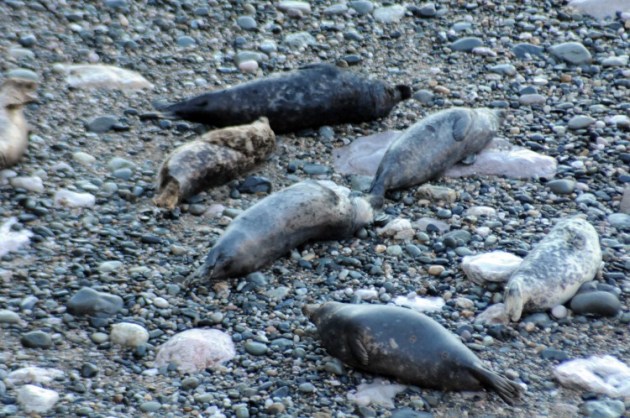More than half of the world’s Grey Seal population lives and breeds around the U.K. coast. The largest populations are found on the Farne Islands, the Cornish coast and Strangford Lough in Northern Ireland, but there is a sizeable population around the rocky North Wales coast. Around the Little Orme there’s the possibility of seeing seals throughout much of the year; there are often one or two swimming around in the sea of the small rocky cove known as Angel Bay and sometimes at low tide there may be one or two hauled out on the beach.
Numbers increase when they are on shore to breed or to moult. Around our UK coasts grey seals breed and pup during the autumn from September to mid December, and the birth of pups peaks during October and November. They moult during June and July.
No-one seems to remember exactly how long Grey Seals have been gracing the sheltered cove with their presence, but it is known to be a good few decades and most people who live locally are well acquainted with their charismatic neighbours. indeed, if you watch the route that most people take when out for a walk or exercising their dogs, I’d bet you’ll see that the majority head for the cliff edge and peer down hoping for a sight of the charismatic mammals either hauled out on the beach below or swimming in the water of the little cove of Angel Bay.
It’s probably fair to say they are local celebrities and are high on the list of sights to see in this area. For much of the year harmony exists between them and us, but as the area receives an increasing number of visitors, particularly during the summer months, it’s apparent that the seals are more frequently disturbed. The cove is quiet and attractive and some are drawn to explore it, clambering down the steep (and slippery!) cliff path to reach it. There is new signage in place to try to deter this and to advise about watching safely and you may find volunteers on hand too, they keep a watchful eye and are happy to give information and answer any questions about the seals.

If people are present on the beach this deters any seals approaching to haul out there to rest. Sometimes the seals hang around in the bay, perhaps crowding onto any exposed rocks, doubtless willing the human intruders to leave.
Folks in kayaks also paddle into the bay hoping for some close encounters, but worse are the noisy ‘pleasure-trip’ motor boats that bring in a succession of tourists over a period of time. There’s a tendency to think that if seals approach us they are curious and as interested in us as we are in them, but it’s most often the case that they are checking and watching closely for any threat we may pose, particularly when they have young ones.
OBSERVING SEALS SAFELY
For much of the year seals are widely dispersed and may be seen almost anywhere along the North and West Wales coasts, even in rivers at times. It is always best to observe seals at a distance. Seals catching sight of people on cliffs or at sea often keep their large dark eyes fixed on what they perceive as a threat, giving an impression of tameness, but in fact are watching the source of danger. They dive with a noisy splash that warns other seals. If seals react to your presence this way, you are too close for their comfort, and unless you back away you may not see any more seals.

Grey Seals in Angel Bay keeping an eye on we observers above

Rushing to the sea to investigate kayakers
GREY SEAL STATS
The scientific name for the Grey Seal is Halichoerus grypus, which unflatteringly translates as ‘hooked-nose sea pig’. They are the third rarest seal in the world and in Britain are protected by law during the breeding season, from September 1st to December 31st, during which period the females come ashore to give birth to their pups.

February 6th 2014-Angel Bay
Grey seals can grow up to 2m in length and live for 40 years. Male (bull) grey seals are the largest mammals found in the UK. They can weigh twice that of our largest land mammal, the red deer. Grey seals differ in appearance from the Common seal in that they have a longer muzzle. The colour of the fur of the adult seals varies from brown to silver-grey, often with darker blotches.
Grey seals differ in appearance from the Common seal in that they have a longer muzzle. The colour of the fur of the adult seals varies from brown to silver-grey, often with darker blotches.

June- A male Grey Seal swimming in Angel Bay
Unusually, Grey seal pups are born with white fur, whereas the young of most animals have colours that blend in with their background to keep them hidden and protect them from predators. The white fur is a throwback to our last ice age: white pups would be well camouflaged in a snow-covered landscape, and these white fur coats show that Grey seals evolved thousands of years ago at a time when these islands were covered with ice and snow. Nowadays the white fur makes the pups too conspicuous, and they begin to moult and darken within just a few days of birth.

September 11th 2015-Abandoned and rescued very new seal pup-Rhos on Sea
At birth, the seal pups weigh around 15kg. The milk produced by their mothers is almost 60 per cent fat. The pups drink about 3 litres a day and their weight increases rapidly, they put on about 35 to 40kg in their first 3 weeks, while at the same time the mothers lose around 70 to 80kg. Females mate again immediately after giving birth, so are almost constantly pregnant!

October 2015-A good-sized group of males & females, some possibly mating
Posts featuring Grey Seals:
March 2016 Sleeping Seals and Stonechats
February 2014 Noisy birds and sleeping seals
January 2014 Grey seals in Angel Bay
September 2011 Baby seal rescue





Pingback: My home is my castle – Ria's belevenissen